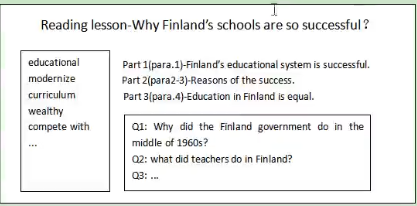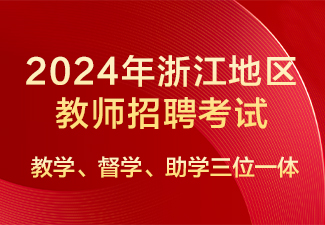杭州中学英语教学设计阅读课2
发布日期:2021-10-01 浏览量:542
[教师资格] 招聘公告 |历年真题 | 笔试资料 | 面试资料 | 冲刺卷
[教师招聘] 招聘公告 | 历年真题| 面试真题 | 在线名师微信答疑:boyueshikao
[课程培训] 金秋启航计划-提前批面试课程 | 刷题打卡 | 免费答疑微信
浙江省各地招考交流群 点击添加 | 关注博越师考微信公众号:boyuejiaoshi

请你根据下面所提供的的阅读教学材料,设计一个课时的教案。需要分析文本,确立教学目标,设计教学活动,并在恰当之处辅以设计意图说明。中英文答题皆可。
For many years the school system in Finland has been very successful. In the PISA survey,
which compares reading, math and science knowledge of 15-year-olds around the world, Finland
is not only the top European country but also competes with Asian giants like Shanghai, Singapore and South Korea. But what makes the educational system in this small country so different from others in the western countries?
Until the 1960s, most Finland's most students left school after six years. In the middle of the
1960s, the Finnish government saw the need to change and modernize their education system if
they want to be internationally competitive. Lawmakers made a simple decision: a basic school for all the 7-to-l6-year-olds. Compulsory education begins at 7. The government makes it possible for all children to attend preschool as well.
Most of Finland's schools get their money from the government. The people who are in charge of the education system, from teachers to officials are trained teachers, not politicians like in other countries.
Teachers work with their pupils in school as much as possible. When teachers are not with the pupils, they spend a lot of time in schools working on the curriculum and new projects. Schools in Finland are small, at least for international standards. So teachers know every pupil in their school and try everything to succeed with their pupils. In contrast to other nations, Finland selects its teachers very carefully: only talented teachers go on to a university and receive a master 's degree in education. Finland only takes the best to educate its youth.
All Finnish children, whether they come from the city or the country, whether from a rich or poor family, have the same chances in education. There are not so many differences between the wealthy and the poor, as in America or other Western European countries. Education experts say that there is very little difference between very good and the worst students. Two thirds of Finnish pupils move on to higher education, the highest rate in the European Union.
Teaching Plan
1. Teaching objectives
(1)Language knowledge and skills: Students are able to read and understand the passage and know
the education system in Finland, they can also master some new words and phrases: educational modernize, wealthy, make a decision, compete with, in contrast to, etc.
(2)Process and methods: Students can get some information by using reading strategies, such as skimming, scanning, predicting, inferring, and so on.
(3)Emotion, attitudes and values: Students can know the difference between Chinese educational system and that of other countries.
2. Teaching key point
Students understand why educational system in Finland is successful and master new words and phrase.
3. Teaching difficult point
Students may find it to difficult to guess the word meaning according to the context and affix, meanwhile, they may also find it hard to use reading skills while reading
4. Teaching procedure
(1)Step 1 Warming up and lead in(5mins)
① sing a song: Young for you
② free talk: Ask students some questions about China's education system and lead them to discuss in groups.
a. Do you like China’s education system?
b. What are the advantages and disadvantages of China’s education system?
c. Do you want to change China’s education system? How to change?
【设计意图】:通过唱歌活跃课堂气氛将学生注意力拉回课堂,通过讨论中国教育体制问题,可以澈发学生想说英语的欲望,锻炼学生的口语能力,同时为引出“芬兰教育体制”铺垫。
(2) Step 2 Pre-reading(3mins)
① Watch a video: Show students a documentary about Finland’s educational system and let them
know some information about it.
② Ask and answer: Ask students some questions(What is the character of Finland’s educational system? What is the difference between Finland's educational system and that of China?)
【设计意图】:通过观看“芬兰教育体制”的纪录片以及讨论中国教育体制和芬兰教育体制的同了解芬兰教育,给予学生提供一定的背景知识,可以更好的服务于阅读文章。
(3)Step 3 While-reading(20mins)
①Skimming: Read the passage quickly and tell “Whats the main idea of each part?” and make a
title for the passage.
Title- Why Finland's schools are so successful?
Part 1(para 1) Finland's school system is successful
Part 2(para 2-3): The reasons of success
Part 3(para). The equal system in Finland
②Scanning: Read the passage again and answer the following questions, use scanning skills
a.What did the Finland government do in the middle 1960s?
b. What did the teachers do in Finland?
③Intensive reading: Read the passage carefully and finish the following tasks
a.Ask and answer(Are children in Finland equated equally? Why does the author mention Shanghai, Singapore, South Korea?)
b.Circle and guess: Read the passage and circle some new words and phrases (educational modernize, curriculum, talented, wealthy, make a decision, compete with, in contrast to, etc ) try to guess the meanings, then T explains to them.
【设计意图】:通过不同形式的阅读任务帮助学生掌握文章大意以及获取文章信息,培养学生阅读策路。
(4)Step 4 Post-reading(12mins)
①Retell: Retell the passage according to the key points with partners
②Discussion: Discuss how to change China's educational system in groups
③Assign homework.
a.Read the passage five times and copy new words and phrases
b.Surf the internet and find out more schools systems in other countries and share them next
【设计意图】:复述课文可以帮助学生再一次加深对文章的印象,同时培养学生的复述能力讨论环节可以开拓学生思维,提高学生口语能力;分层以及开放式的家庭作业可以面向全体生,关注不同学习者的个体差异性。
5.Blackboard design

6. Teaching Reflection
(1) Overall, the teaching procedure is designed according to the teaching material and learning condition.
(2) It’s a learner-centered lesson, in which Ss are encouraged to learn through experiencing, cooperating and exploring.
(3) However, due to the time limitation, Ss may find it hard to act it out with correct pronunciation and intonation. T should pay attention to the arrangement and discipline management due to the variety of activities.






